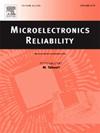Cu/In-Sn-xZn-yAg/Cu焊点热时效后的组织与性能
IF 1.9
4区 工程技术
Q3 ENGINEERING, ELECTRICAL & ELECTRONIC
引用次数: 0
摘要
采用瞬态液相键合法制备了Cu/In-Sn-5Zn/Cu和Cu/In-Sn-2.5Zn-50Ag/Cu焊点。将焊点分别在50℃、75℃和100℃时效1008 h,研究焊点的组织演变和抗剪强度变化。长期热时效后,Cu/ in- sn - 5zn /Cu焊点在原位反应区出现裂纹。Ag纳米颗粒的加入导致Cu/In- sn -2.5 zn - 50ag /Cu焊点中Ag₃In相的生成,这些相分散在原位反应区,有效地阻碍了裂纹的扩展。长期热时效后,Cu/ in - sn - 5zn /Cu焊点界面反应区出现了Kirkendall空洞聚集形成的潜在裂纹扩展区。Ag颗粒的加入抑制了Cu₃(In,Sn)金属间化合物(IMC)的过度生长和Kirkendall空洞的形成,使焊点在长期热时效后仍能保持致密的界面结构和较高的剪切强度。Cu/ in- sn - 5zn /Cu焊点的原位反应区裂纹和界面反应区Kirkendall空洞影响其抗剪强度和断口位置。Cu/ in- sn -2.5 zn - 50ag /Cu焊点断裂位置相对稳定,均发生在原位反应区。本文章由计算机程序翻译,如有差异,请以英文原文为准。
Microstructure and properties of Cu/In-Sn-xZn-yAg/Cu solder joints after thermal aging
Cu/In-Sn-5Zn/Cu and Cu/In-Sn-2.5Zn-50Ag/Cu solder joints were prepared by Transient Liquid Phase (TLP) bonding. The solder joints were aged at 50 °C, 75 °C and 100 °C for 1008 h to study the microstructural evolution and changes in shear strength. After long-term thermal aging, cracks appeared in the in-situ reaction zone of Cu/In-Sn-5Zn/Cu solder joints. The addition of Ag nanoparticles led to the generation of Ag₃In phases in Cu/In-Sn-2.5Zn-50Ag/Cu solder joints, which were dispersed in the in-situ reaction zone and effectively hindered crack propagation. After long-term thermal aging, potential crack propagation regions formed by the aggregation of Kirkendall voids appeared in the interfacial reaction zone of Cu/In-Sn-5Zn/Cu solder joints. The addition of Ag particles inhibited the overgrowth of Cu₃(In,Sn) intermetallic compound (IMC) and the formation of Kirkendall voids, enabling the solder joints to maintain a dense interfacial structure and high shear strength after long-term thermal aging. The cracks in the in-situ reaction zone and Kirkendall voids in the interfacial reaction zone of Cu/In-Sn-5Zn/Cu solder joints affected the shear strength and fracture location. The fracture locations of Cu/In-Sn-2.5Zn-50Ag/Cu solder joints were relatively stable and all occurred in the in-situ reaction zone.
求助全文
通过发布文献求助,成功后即可免费获取论文全文。
去求助
来源期刊

Microelectronics Reliability
工程技术-工程:电子与电气
CiteScore
3.30
自引率
12.50%
发文量
342
审稿时长
68 days
期刊介绍:
Microelectronics Reliability, is dedicated to disseminating the latest research results and related information on the reliability of microelectronic devices, circuits and systems, from materials, process and manufacturing, to design, testing and operation. The coverage of the journal includes the following topics: measurement, understanding and analysis; evaluation and prediction; modelling and simulation; methodologies and mitigation. Papers which combine reliability with other important areas of microelectronics engineering, such as design, fabrication, integration, testing, and field operation will also be welcome, and practical papers reporting case studies in the field and specific application domains are particularly encouraged.
Most accepted papers will be published as Research Papers, describing significant advances and completed work. Papers reviewing important developing topics of general interest may be accepted for publication as Review Papers. Urgent communications of a more preliminary nature and short reports on completed practical work of current interest may be considered for publication as Research Notes. All contributions are subject to peer review by leading experts in the field.
 求助内容:
求助内容: 应助结果提醒方式:
应助结果提醒方式:


